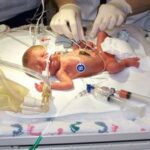The medical condition known as kernicterus (nuclear jaundice) is caused by excessive staining and damage to certain parts of the brain, particularly the basal ganglia (the nerve center at the base of the brain), the bilirubin, a bile pigment. An amount of jaundice sufficient to cause damage usually appears during the first week of life, especially if the baby is premature or has brain damage.
All babies develop minor jaundice during the first week of life. This is the result of the infant’s excessive stores of blood at birth being rapidly broken down to normal levels. At the same time large amounts of bile pigments are produced, broken down and excreted. The healthy newborn infant can cope with these pigments, provided it has a mature liver and sufficient albumen (protein) levels in the blood to attach to the pigment molecules.
An excessive break down of blood, which occurs in Rh-incompatibility (erythroblastosis fetalis) and mother-baby blood group (ABO-) incompatibility, places an extra load on the liver, with subsequent accumulation of pigment to very high levels. Toxic levels of free unbound pigment will develop when the liver is immature, and if the serum albumen levels are low, as occurs in prematurity and following the giving of certain drugs (for example, sulpha drugs, salicylates) which compete with the pigment in binding the albumen.
Symptoms
The infant first becomes apathetic, appears to have difficulty feeding, and then tends to vomit. The face becomes expressionless and subsequently the head retracts backwards. Bulging of the fontanelle, or “soft spot”, occurs, the cry becomes shrill and convulsions are frequent. As the condition worsens the eyes look downwards progressively, producing the ‘setting sun. Up to 75 per cent of affected babies die. Any recovery is only partial, with deafness, mental retardation and athetoid or writhing spasticity almost invariable.
If there is brain damage before the jaundice appears, as in very difficult births or when the baby is deprived of sufficient oxygen, the parts of the brain that have been affected are more likely to be further damaged by bile pigment.
Treatment
Great emphasis is made to avoid circumstances in which the baby may be at risk. If prematurity or difficult delivery is anticipated, the pregnant mother will be cared for at a major obstetric hospital.
When the baby appears jaundiced, pigment levels are monitored closely. Extra fluids or albumen may be given, certain drugs are avoided, and in the premature infant, phenobarbitone is occasionally prescribed, it being recognized that in some indeterminate way the liver then matures and can cope more adequately with the pigment. If jaundice reaches approximately half the toxic level, the infant is placed under blue lights of particular intensity. This causes a drop in bilirubin in the blood. Should two-thirds the toxic level be reached the baby’s blood is replaced with bile pigment-free blood by an exchange transfusion.
Source:
Kernicterus & Newborn Jaundice
www.kernicterus.org


